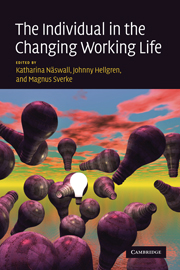Book contents
- Frontmatter
- Contents
- List of figures
- List of tables
- List of cases
- List of contributors
- Acknowledgements
- 1 The individual in the changing working life: introduction
- Part I Threats and challenges
- Part II Individual attempts at restoring the balance
- Part III Intervention and promotion on the organizational level
- 17 Participatory action research as work stress intervention
- 18 Enhancing work engagement through the management of human resources
- 19 Prevention: integrating health protection and health promotion perspectives
- 20 Workplace interventions for occupational stress
- Index
- References
17 - Participatory action research as work stress intervention
Published online by Cambridge University Press: 13 October 2009
- Frontmatter
- Contents
- List of figures
- List of tables
- List of cases
- List of contributors
- Acknowledgements
- 1 The individual in the changing working life: introduction
- Part I Threats and challenges
- Part II Individual attempts at restoring the balance
- Part III Intervention and promotion on the organizational level
- 17 Participatory action research as work stress intervention
- 18 Enhancing work engagement through the management of human resources
- 19 Prevention: integrating health protection and health promotion perspectives
- 20 Workplace interventions for occupational stress
- Index
- References
Summary
Work stress is a major concern in all developing and industrialized countries, affecting not only employees but also organizations and society as a whole. Over the past decades, the workplace has changed substantially owing to globalization of economic activities, increased utilization of information and communication technology, growing diversity in the workplace (e.g. more women, and older and more highly educated people, as well as increased migration, particularly between the EU member states), flexible work arrangements, and changed organizational work patterns (e.g. Just in Time management) (European Foundation for the Improvement of Living and Working Conditions [EFILWC], 2005; Landsbergis, 2003; Le Blanc, de Jonge, and Schaufeli, in press). The impact of the global economy has also led to an increase in knowledge- and service-based organizations. One of the most striking developments, however, is the changing nature of work itself and increased workloads. Nowadays, for many employees, work poses primarily mental and emotional demands instead of physical ones (de Jonge and Dormann, 2003; de Jonge, Mulder, and Nijhuis, 1999).
These recent developments in working life are reflected by a marked increase in (scientific) research on work stress, its causes, and its consequences. Moreover, researchers, managers, and policy makers seek gold standards in the evidence base for policy and practice. Increasingly, cost-benefit analyses of work stress interventions are sought and there is a growing recognition that health and well-being measures are a quintessential component of organizational performance analysis.
- Type
- Chapter
- Information
- The Individual in the Changing Working Life , pp. 353 - 379Publisher: Cambridge University PressPrint publication year: 2008
References
- 14
- Cited by

